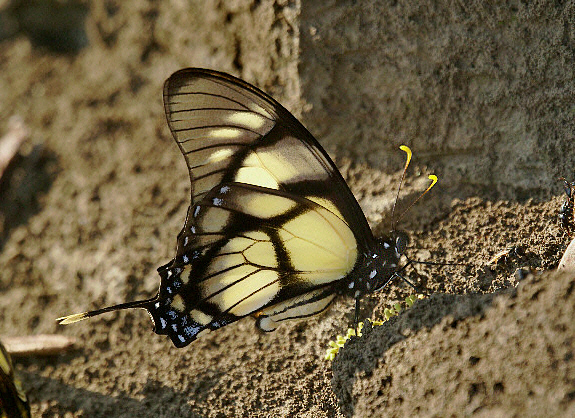
Introduction
The genus Eurytides is comprised of 7 neotropical species. It is closely allied to the genera Protesilaus and Protographium, the three genera being known collectively as Swordtails, due to the long narrow projections on their hindwings.
The Dolicaon Swordtail has distinctive black bars on the hindwing, and can only be confused with one other species E. iphitas, but the latter has more rounded hindwings, and a yellow ground colour, while dolicaon is always a purer slightly creamy white.
This species is distributed from Panama, Colombia and Venezuela in the north, down to southern Peru, the Mato Grosso of Brazil, and possibly also Bolivia.
Habitats
Eurytides dolicaon is a lowland species, found in association with wet primary rainforest at altitudes from sea level to about 400m.
Lifecycle
I have no information regarding this particular species, but the following descriptions apply generally to the genus Eurytides :
The eggs are typically white, globular, and laid singly on the young leaves of Guatteria, Annona or Sapranthus ( Annonaceae ). Females tend to repeatedly visit a chosen plant, upon which they may lay several eggs during the course of a few hours.
The larvae are wedge-shaped, tapering towards the tail end, and with the thoracic segments enlarged. They are generally greenish, marbled or spotted with darker markings, and are not adorned with spines or tubercles. They normally rest with the head and tail slightly raised.
As with all other Papilionids the larvae are equipped with an eversible osmaterium – a pair of fleshy forks on the first segment, from which airborne chemical compounds are disseminated. Various theories have been postulated as to the purpose of these pungent odours, which appear to have no effect on avian predators or dipteran parasitoids. It has been suggested that they may serve to warn off ants that might otherwise molest them.
The pupae are usually brownish, with a prominent thoracic keel, and resemble small pieces of dirty wood. They are always fixed vertically by the cremaster and a silken girdle to twigs.
Adult behaviour
This species in my experience is always seen singly.
The butterflies have a rapid straight-line flight at canopy level, but will descend when migrating along river courses, and visit wet sandbanks in company with groups of mud-puddling Protographium and Protesilaus species. All three genera “filter-feed”, sucking up large quantities of water, from which they extract dissolved minerals, while regularly squirting jets of expelled liquids from the anus. The fact that all three genera aggregate at certain spots, usually separate from feeding groups of Nymphalidae or Pieridae, suggests that they are reliant upon particular minerals that are concentrated in one area.
This species, more so than other Swordtails, is hesitant and nervous when visiting sandbanks. It tends to dip down, briefly taste the damp sand to test its suitability, and then move on, but having found a suitable feeding spot, usually where other Swordtails are aggregating, it will remain settled for several minutes.
